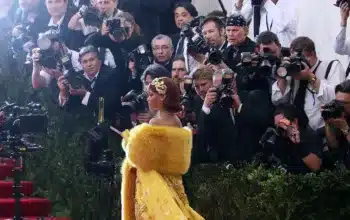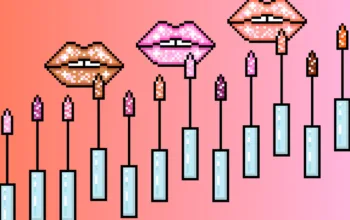Author Sara Petersen on how a certain image of motherhood took over social media and makes moms feel bad.
The momfluencer has a perfect kitchen.
Her dishes are washed, her countertops are clean, and her walls are a pristine landscape of eggshell white. Not coincidentally, she is also white. She is thin, able-bodied, young but not too young. She has somewhere between two and 10 kids. She puts her baby in a Moses basket, her toddler in an Uppababy stroller, and her older kids in earth-toned separates that match her own maxi dresses and wrap sweaters. All these products are expensive, but they can be discounted if you use her code.
The momfluencer, obviously, is not a real person. She’s a construct, created by real mothers in the mid-aughts, in concert with tech companies and consumer brands, as a way of making a living on social media. Today, momfluencers are big business for advertisers, since women make the majority of household purchasing decisions, and moms in particular are often the ones choosing big-ticket items such as strollers and cribs. They also hold cultural importance — more than ever, they’re the ones communicating messages to the rest of us about what motherhood should look like.
Sara Petersen, a New Hampshire-based writer and mother of three, has been following the rise of this unique brand of influencer for nearly 10 years, since, she says, “I had a newborn and a toddler and was simultaneously lured in by the rosy depictions of motherhood while also feeling like I was being sold a partial truth.” Her new book, Momfluenced, released this week, looks at how momfluencers became the economic force they are today; how their images and videos replicate the sexism, racism, and classism baked deep into American family life; and how their aestheticized version of parenthood has gotten inside our heads.
I spoke with Petersen by phone about those issues and why we should all care about momfluencers, in a conversation that has been condensed and edited for clarity, and that was interrupted briefly by my sick 4-year-old, reminding us all of the messiness of real-life parenting.
/cdn.vox-cdn.com/uploads/chorus_asset/file/24596963/headshot__2.jpg)
Courtesy of Sara Petersen
What is a momfluencer?
The simplest definition is someone who has monetized her maternal identity on social media. I sort of broaden the definition to really explore anyone who performs motherhood on social media, whether they have 100,000 followers or 20 followers.
We perform motherhood on various stages throughout our lives, but our performances on social media can be revealing in terms of what we perceive to be valuable about mothers and what we don’t perceive to be valuable about mothers.
Can you talk a little bit about the evolution of momfluencing? When did this start, and how did it progress to where it is now?
The early mommy bloggers like Heather Armstrong, Natalie Lovin — that was the early- to mid-aughts — made money off of their blogs primarily by banner ads. A company would have an ad that they had already created, and pay the mommy blogger for them to just put the ad on the side of their blog. Their blogs were largely personal narrative-driven. They were word-heavy versus image-heavy. And often, they were really unvarnished. They opened up a lot of dialogues about maternal mental health, and about the struggles that mothers have always been experiencing, but that I don’t think had really been introduced to the mainstream.
Once Instagram became a thing, many of these mommy bloggers transitioned to Instagram, which was very image-focused and dedicated to selling a certain aesthetic that often hinged on “authenticity.” It was very much about celebrating the beautiful in the everyday and making one’s life look like art. When that happened, you know, image was king, and the monetization model also changed. Some of the early mommy bloggers became savvy about how much marketing influence they were having on consumers and demanded to be paid for their work. And so now, the monetization model is centered on sponsored content, so a momfluencer can get paid to post, you know, two Instagram Stories, a reel, and a post about a baby carrier or whatever.
How big a part of the influencing economy more generally are momfluencers? Why do brands want moms?
One reason, in addition to just the sheer numbers of mothers on social media and numbers of women actively engaging with social media on a daily basis, is the fact that motherhood encompasses so many consumer categories. You can sell moms couches, you can sell them vacuums, you can sell them nap dresses, you can sell them diapers, you can sell them books about child-rearing. Almost everything in contemporary life can be directly linked to becoming a “good mother.” Many of us roll into motherhood completely unprepared and relatively clueless about it and we certainly don’t have many systemic supports in this country. As a result, I think many of us are understandably looking for ways to make motherhood easier or ways to do motherhood “right.”
Can you talk about the economics of momfluencing a little bit from the influencer side? Why do people do this? Do they make good money from it?
Some of them do, but I would say not many. In her book, (Not) Getting Paid To Do What You Love, Brooke Erin Duffy — who studied influencers across the board, not just momfluencers — estimated that only 9 percent make enough to live on. The tippy-tippy top, super-successful ones make a ton of money when they have huge brand partnerships with Amazon, for example.
I think that is one of the misconceptions, that it’s easy, that you just take a few pretty pictures and the money will come flooding in. That’s just not the case.
Another trope is the idea that if you are an influencer, you are still staying home with your kids, but you’re also making money. Is that part of the draw, in theory, of being a momfluencer?
I totally think that’s a huge draw, and it’s an indictment of the lack of flexibility and humanity in most professional work environments. If every caregiver and parent knew that they could get child care on site or wherever their workplace was located, and that child care was quality and paid for, I don’t know how much MLMs would be thriving, or these sort of dubious promises of work-life balance for mothers.
I also think it’s not fully the case — yes, you can be at home with your kids. But if you’re a full-time momfluencer, you’re working. You’re taking photos, you’re editing, you’re writing copy, you’re dealing with emails for brands and sponsorships. Chances are, you probably need child care too!
/cdn.vox-cdn.com/uploads/chorus_asset/file/24596964/MOMFLUENCED_cover_art.jpeg)
Why do people follow these influencers?
Everybody’s reasoning differs depending on their cultural context and their personal backgrounds. I do think many of us gravitate toward momfluencers who we perceive to be succeeding in ways that we perceive ourselves to be failing. My kryptonite has always been the joyful mom, the easy mom, the mom to whom motherhood seems to be coming really naturally. Other people might gravitate toward mothers with impeccably organized playrooms or whatever.
Can you talk about the tradwife and tradmom phenomena? What does it mean to be a tradmom on Instagram or TikTok, and why do people — including those who decidedly are not tradmoms — follow these accounts?
Broadly speaking, a tradmom or tradwife is someone who adheres to traditional gender norms. This might look like somebody who’s wearing a dress that could be mistaken for having been made in the 1880s. Or it could be somebody who really wants to make sure her husband has a sandwich when he wants a sandwich.
The tradmom accounts that are aesthetically grounded in some sort of sense of nostalgia or some sort of “simpler time” do appeal to those of us who are firmly centered in the complicated now. I think it comes back to this human need to hope for things. We want to hope that, for example, work-life balance can be more equitable for women in this country and mothers in this country. We want to hope that we won’t always feel so frenzied and burnt out in our roles as mothers. So I think one reason that we follow is a sense of escapism, like, this woman is kneading her sourdough and milking her cows, and it feels wholly removed from my life. I don’t feel like I have to compare myself to it because it’s completely different from my everyday.
But I think it’s insidious in that it assumes that there was a sense of purity or rightness in a time when most women were oppressed. When we think, it was simpler then, it was easier then, we have to ask, who was it simpler or easier for? And the answer is usually white, rich men.
You talk a lot in the book about the whiteness of momfluencing, and how the momfluencers who make the most money tend to be white, cis, thin, and straight. But you also talk to moms who don’t fit into those categories — moms who are fat, for example, and Indigenous moms — who find community on social media or who have a more nuanced profile as influencers. Can you talk about visibility in momfluencing, who is represented and who isn’t?
It would be remiss of anybody to denigrate all social media influencer accounts because they are really a democratic way to spread awareness about social issues and a relatively easy way to create communities and support networks where otherwise it might be harder to access. And so much of it is just like being stuck in your own echo chamber — if you’re only following the beachy waves white mommies in their Nantucket mansions or whatever, you’re only going to keep seeing the beachy waves moms and their Nantucket mansions. The algorithm will feed you what it thinks you want to see.
I remember talking to Myleik Teele in the book about how white momfluencers still make the vast majority of money in this industry. She was talking about when she was trying to pitch her haircare company, there was an Herbal Essences product that was the Holy Grail of hair products for Black women. She was trying to explain this to somebody who she was trying to get funding from, and none of the people in that meeting were Black, and therefore they didn’t know about this. My point in bringing this up is, if the majority of people forging these marketing deals and sponsored content deals are white men, then they’re going in with their own assumptions about what sells and what mothers want to see. So in every stage of this ecosystem, there are imbalances to blame for the pervasiveness of the whiteness we’re being fed.
Let’s talk about TikTok. Instagram was really the dominant platform for momfluencers for a while, but now it seems like TikTok is ascendant as people feel like they can go viral more quickly there. How is TikTok changing momfluencing?
One major differentiator is that it’s way less polished-image-focused. With so many smart, brilliant TikToks, the lighting’s shitty, you don’t get the sense that anything was super orchestrated or staged. And that doesn’t seem to be where the value lies. The value really seems to lie in the quality of the messaging itself.
Does that allow a bigger diversity of momfluencers, or a different kind of momfluencer, to build a following?
I think so. Both Kc Davis and Laura Danger are big on Instagram, but they’re huge on TikTok. TikTok is where they first built their platform. Laura Danger talks about gendered inequity within the home, and Kc Davis talks about the moral neutrality of care work. These are both really specific, meaningful issues that impact most moms on a daily basis. Both of these accounts are about the specifics of mothering and caregiving labor rather than the performance of maternal identity.
There’s also been a movement toward more relatable moms, on Tik Tok especially. I’m thinking about Kathryn Jezer-Morton’s recent newsletter about the rise of the messy house on TikTok, for example. Is momfluencing getting more real? Is it just on the way out? Are people tired of aspirational mom content?
This question is so hard for me because I have to check my own echo chamber. I feel like you and I probably consume similar content and are having these conversations about rejecting these ideals and interrogating these ideals. And I think many moms post-pandemic are thinking similarly, along the lines of, who are these ideals for and who are they hurting? I think many of us are also more conscious of our social media usage post-pandemic.
That being said, I do think that the “ideal” white mother is still making the most money as a momfluencer. Also, all of the either openly white supremacist or tradwife momfluencers I feature in the book, when I first started writing the book, I recorded all their follower counts, and when I went back to do final edits, all of their counts had grown precipitously.
On the one hand, I see some mothers becoming really aware of the toxicity of celebrating one type of “ideal” mother, and becoming really politically engaged in terms of trying to improve conditions for all mothers. I also think we’re more aware that many of the things that we’re struggling with in our daily lives are the result of systemic inequities, not our personal failings. But I think alongside that are also people that feel like their ways of life are under attack and feel like the nuclear family is under attack. I see both things happening simultaneously and maybe in direct relation to each other.
That makes sense. I have one more question, but I’m going to go check on my kid because he’s kind of making groaning noises. [Several minutes elapse.] Okay, he’s fine.
What can we learn from momfluencers about our culture as a whole and about what parents need? Are we turning to momfluencers because our culture is devoid of community and support?
I do think we are drawn to momfluencers because we’re so devoid of easily accessible support networks in contemporary life. I think just understanding that these ideals are cultural constructs that are not a reflection of any supposedly natural way to exist as mothers is really freeing and helpful.



